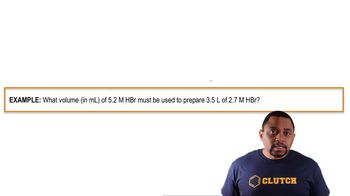Here are the essential concepts you must grasp in order to answer the question correctly.
Buffer Solutions
A buffer solution is a system that resists changes in pH upon the addition of small amounts of acid or base. It typically consists of a weak acid and its conjugate base, or a weak base and its conjugate acid. In this case, lactic acid (weak acid) and sodium lactate (conjugate base) form a buffer that helps maintain a stable pH.
Recommended video:
Henderson-Hasselbalch Equation
The Henderson-Hasselbalch equation is a mathematical formula used to calculate the pH of a buffer solution. It is expressed as pH = pKa + log([A-]/[HA]), where pKa is the negative logarithm of the acid dissociation constant, [A-] is the concentration of the conjugate base, and [HA] is the concentration of the weak acid. This equation is essential for determining the pH of the buffer in the given problem.
Recommended video:
Henderson-Hasselbalch Equation
Dilution and Concentration Calculations
When mixing solutions, the final concentrations of the components must be calculated based on their initial concentrations and volumes. The total volume after mixing affects the concentrations of lactic acid and sodium lactate, which are necessary for applying the Henderson-Hasselbalch equation. Understanding dilution principles is crucial for accurate pH calculations in buffer solutions.
Recommended video:
Dilution Calculation Example





